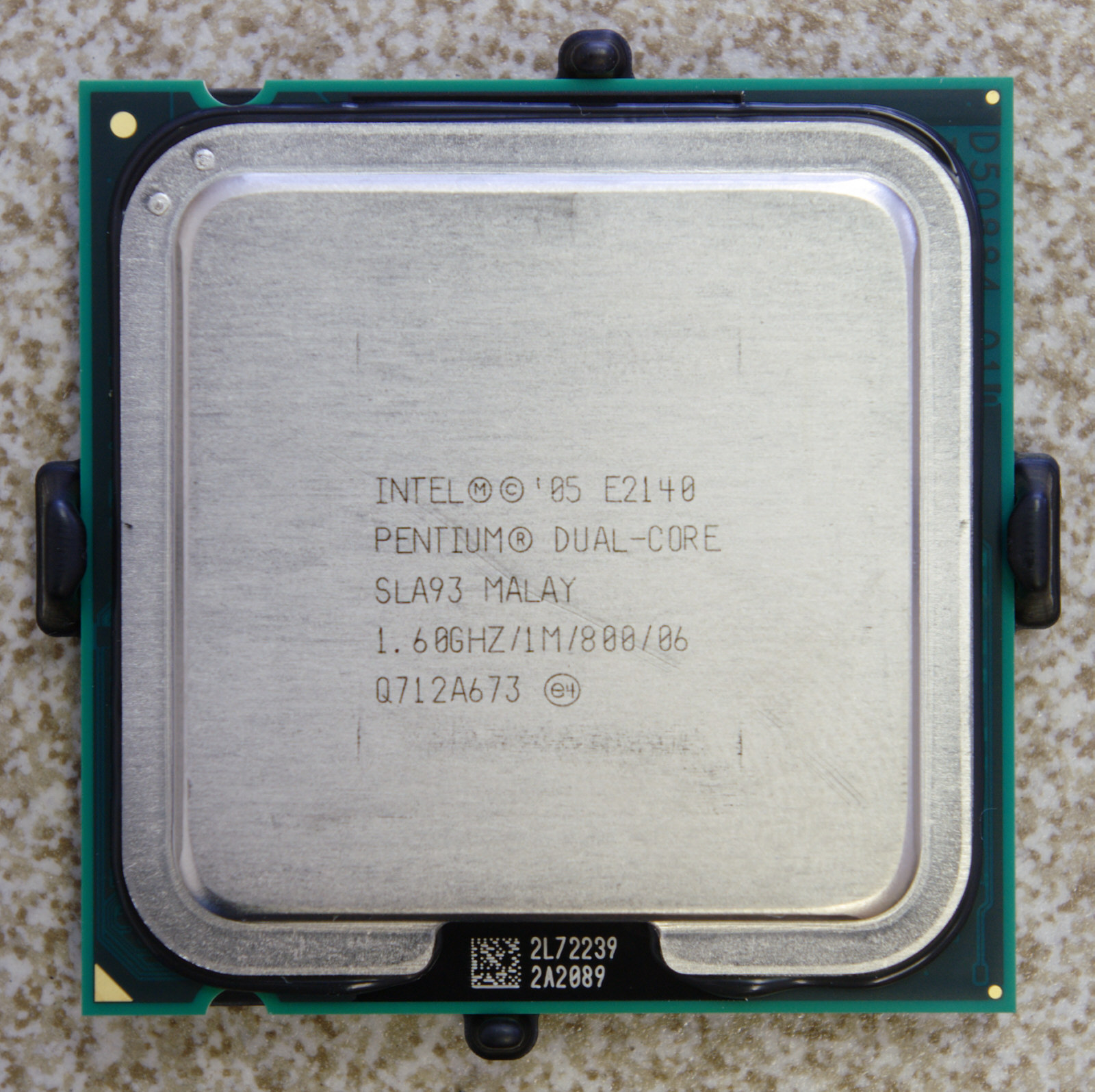- Intel Pentium Dual-Core
Infobox Computer Hardware Cpu
name = Pentium Dual-Core

caption = Intel Pentium Dual-Core E2140
produced-start = From 2006
produced-end =
slowest = 1.4 | slow-unit = GHz
fastest = 2.5 | fast-unit = GHz
fsb-slowest = 533 | fsb-slow-unit = MT/s
fsb-fastest = 800 | fsb-fast-unit = MT/s
manuf1 = Intel
size-from = 0.065 to 0.045
arch = MMX, SSE,SSE2 ,SSE3 ,SSSE3 ,x86-64
microarch = Core Microarchitecture
sock1 = LGA 775 (Socket T ), Socket M, Socket P
numcores = 2The Pentium Dual-Core brand refers to mainstreamx86 -architecturemicroprocessor s fromIntel . They are based on either the 32-bit "Yonah" or (with quite differentmicroarchitecture s) 64-bit "Merom" or "Allendale" processors targeted at mobile or desktop computers respectively.In 2006,
Intel announced a plan [ [http://www.dailytech.com/article.aspx?newsid=4252 DailyTech - Intel "Conroe-L" Details Unveiled ] ] to return thePentium brand from retirement to the market, as a moniker of low-costCore architecture processors based on single-core Conroe-L, but with 1 MB cache. The numbers for those plannedPentium s were similar to the numbers of the latter Pentium Dual-CoreCPU s, but with the first digit "1", instead of "2", suggesting their single-core functionality. Apparently, a single-core Conroe-L with 1 MB cache was not strong enough to distinguish the plannedPentium s from other plannedCeleron s, so it was substituted bydual-core CPU s, bringing the "Dual-Core" add-on to the "Pentium" moniker.The first processors using the brand appeared in notebook computers in early 2007. Those processors, named Pentium T2060, T2080, and T2130 [cite web |title=Intel Pentium E2140 & E2160 review |url=http://www.techspot.com/review/53-pentium-e2140-e2160/ |publisher=TechSpot |accessdate=2007-06-23] , had the 32-bit
Pentium M -derived Yonah core, and closely resembled the Core Duo T2050 processor with the exception of having 1 MB L2cache instead of 2 MB. All three of them had a 533 MHz FSB connectingCPU with memory. "Intel developed the Pentium Dual-Core at the request of laptop manufacturers" [ [http://asia.cnet.com/reviews/pcperipherals/0,39051168,61998152-8,00.htm Rec] ] .
Subsequently, on
June 3 2007 , Intel released the desktop Pentium Dual-Core branded processors [cite news |title=Pentium E/Celeron 400 to be releasing on June 3 |url=http://www.hkepc.com/bbs/itnews.php?tid=755292 |publisher=HKEPC Hardware |accessdate=2007-03-16] known as the Pentium E2140 and E2160 [cite news |title=Intel Readies Pentium E2000-Series Processors |url=http://www.xbitlabs.com/news/cpu/display/20061115223825.html |last=Shilov |first=Anton |publisher=X-bit labs |accessdate=2007-03-04] . A E2180 model was released later in September 2007. These processors support theIntel64 extensions, being based on the newer, 64-bit Allendale core withCore microarchitecture . These closely resembled the Core 2 Duo E4300 processor with the exception of having 1 MB L2cache instead of 2 MB [cite web |title=Intel Pentium E2140 & E2160 review |url=http://www.techspot.com/review/53-pentium-e2140-e2160/ |publisher=TechSpot |accessdate=2007-06-23] . Both of them had an 800 MHz FSB. They targeted the budget market above theIntel Celeron (Conroe-L single-core series) processors featuring only 512 kB of L2cache . The 45nm E5200 model was released byIntel onAugust 31 2008 , with a larger 2MB L2 cache over the 65nm E21xx series and the 2.5GHz clock speed. The E5200 model is also a highlyoverclock able processor, as the Taiwanese computer enthusiast "Coolaler" was able tooverclock an enginnering sample of the E5200 to a high 4.0GHz clock speed.Such a step marked a change in the
Pentium brand, relegating it to the budget segment rather than its former position as the mainstream/premium brand. [http://www.tomshardware.com/2007/09/12/pentium_dual_core/ An article] onTom's Hardware claims that these CPUs are highlyoverclock able.Comparison to the Pentium D
Although using the "Pentium" name, the Pentium Dual Core is based on the Core technology, which can clearly be seen when comparing the specification to the
Pentium D series. For example, the Pentium Dual Core has a maximum of 2MB of L2 Cache while the Pentium D processors can have up to 4MB of L2 Cache. But the major difference is the Pentium Dual Core processors only consume 65W peak while the Pentium D consumes a considerable 130W peak consumption which shows its relation to the Core power saving technology. Despite having a smaller L2 cache, the Pentium dual-core has proven to be much faster than the Pentium D under a variety of CPU intensive applications.http://youtube.com/watch?v=253RHrXXlUkee also
*
List of Intel Pentium Dual-Core microprocessors References
[http://www.intel.com/products/processor_number/chart/pentium_dual-core.htm Intel Processor Numbers chart for Intel Pentium Dual-Core processors]
Wikimedia Foundation. 2010.
